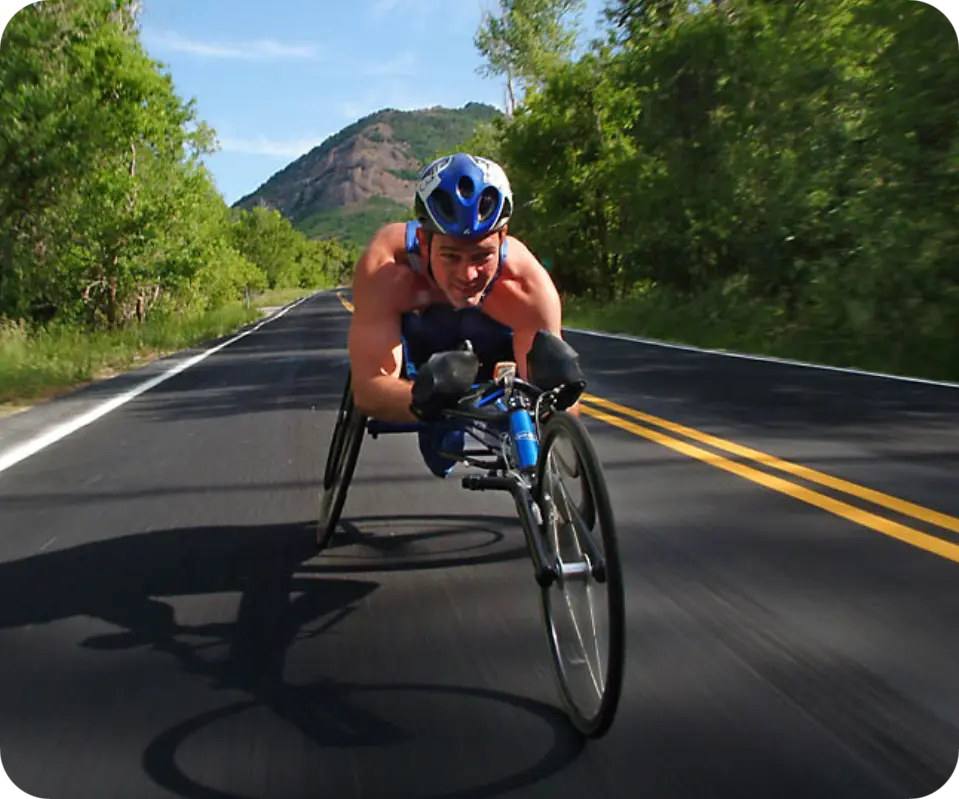
Feb 13, 2019 • 6 min read
Paralympic Track Medalist Chris Waddell on What It Takes to Win
Posted in:
 There aren’t many folks humbler than Chris Waddell–the legendary record-setter in both Paralympic track and ski events. He’ll chat you up while sporting a wide, open smile, and casually forget to tell you about his three World Championship track medals (he won gold in the 200m in 1998, the same year he won Paralympic and World Championship gold in skiing) and his Paralympic 200m silver in 2000. There are also his eight National Championship track titles, three US records (200m, 400m, and 800m), and his golden ski career: He’s the most decorated sit-skier of all time.
There aren’t many folks humbler than Chris Waddell–the legendary record-setter in both Paralympic track and ski events. He’ll chat you up while sporting a wide, open smile, and casually forget to tell you about his three World Championship track medals (he won gold in the 200m in 1998, the same year he won Paralympic and World Championship gold in skiing) and his Paralympic 200m silver in 2000. There are also his eight National Championship track titles, three US records (200m, 400m, and 800m), and his golden ski career: He’s the most decorated sit-skier of all time.
Waddell broke his back in a skiing accident in 1988, and a short time later went on to win 12 Paralympic medals (five of which are gold), six World Championship medals (three of which are gold), and get ready for it: 32 National Championship titles. To top it off, he’s the first paraplegic to climb Mt. Kilimanjaro, and in his humble words the ascent was, “nearly unassisted.”
These days Waddell tours the country speaking at schools and corporations, and reminds others that life and success aren’t about what happens to you, but rather what you do about it. He’s currently working on a multi-media memoir entitled Controlled Fall.
His book may be in the works, but we sat down with Waddell to talk to him about juggling multiple sports in winning fashion, and particularly about his experience with track. Prepare to be inspired.
TeamSnap: What was your favorite moment as a track athlete?
Chris Waddell: That would be at the World Championships in ‘98. I won in the 200 but was third in the 400–and the 400 was a greater moment for me. I was winning up until the last five meters, and then two guys passed me. One of my heroes, Heinz Frei (Switzerland) was in the race, and he was the world record holder. He was such a great athlete and I was right there, just behind him. That was my first individual World Championship medal in track. I remember thinking when it happened, “I could actually be good at this!”
TS: What are some training tips for track athletes?
CW: Things are a little different with wheelchair racing–it’s almost more like swimming, the way you carry your speed. I’d do a two-mile warm-up, for example, and my warm-up was probably more distance than Carl Lewis would do in a week.
That said, interval training is where I started to find some speed. Training intervals can help you realize you can go that fast.
Another tip would be to focus on finding where you’re fastest, in terms of your technique. Make your training race-oriented and purposeful. You have your start, acceleration, and max speed–three general yet distinct parts of a sprint, so figure out what you do well and how you can do it better. When I’m coaching, I also tell athletes to focus on only one thing each training session. For example, one day you could focus on your max speed. I could never make it to my max speed in the 100m. In the 200 I could.
Finally: Find a coach and/or seek professional advice, so you have someone who can give you feedback. You know how you feel, but sometimes how you feel is not what you see or are doing. Video is a good teaching tool, but it doesn’t always work. A coach can give you honest feedback, and perhaps even see things you can’t.
TS: What did you typically feel before the gun went off?
CW: I was strategic, and would try to be quiet. That way I could allow myself to react quickly. The reaction at the start is such an important part of the race. You try to time the cadence of the gun. It’s, ‘On your mark, set,’ and–that’s often two seconds, so I’d prepare.
The more you can clear your mind, the better shape you’ll be in. You’ve already done your work in training, and when you’re as blank as possible, your body can react. Training is about teaching your muscles instinct. Racing is about letting your instinct be what it’s supposed to be.
TS: How did you calm your nerves at events in general?
CW: That was always my biggest challenge. Leading up to the actual event, I simply tried not to think about it. There were times I was telling jokes and talking and then suddenly, it was time to go. That worked better for me. Otherwise, I could grind on things, and over-thinking didn’t help. I tried to step back from it.
TS: What are the benefits of competing in different sports?
CW: I’d been a skier before my accident, but track was a relatively new sport to me. I was learning more about it as I was doing it, and with track I had bigger breakthroughs. It was exciting, and competing in two sports kept me mentally fresh.
TS: Juggling two sports and at such a high level must have been difficult. What were some management challenges you encountered that could have been solved with an app like TeamSnap?
CW: Scheduling was always my biggest challenge, whether in terms of competition or my workouts. My coach would give me workouts and there were times and days when I didn’t know what I was supposed to do.
There was also the travel schedule to manage. Coordinating schedules and connecting was difficult back then. It still is!
~~~
Lara Rosenbaum is an award-winning journalist and wellness expert whose work has appeared in SELF, Shape, Men’s Health, Runner’s World, Men’s Journal, Prevention, Yoga Journal and many other publications. She has held editorial positions at several magazines and brands, including Women’s Health, where she was the founding fitness editor, and at Fitbit. Lara is also a former elite athlete, having traveled the world as a member of the U.S. Freestyle Ski Team. In her free time she enjoys traveling, playing with her dogs, and adventuring outside.
